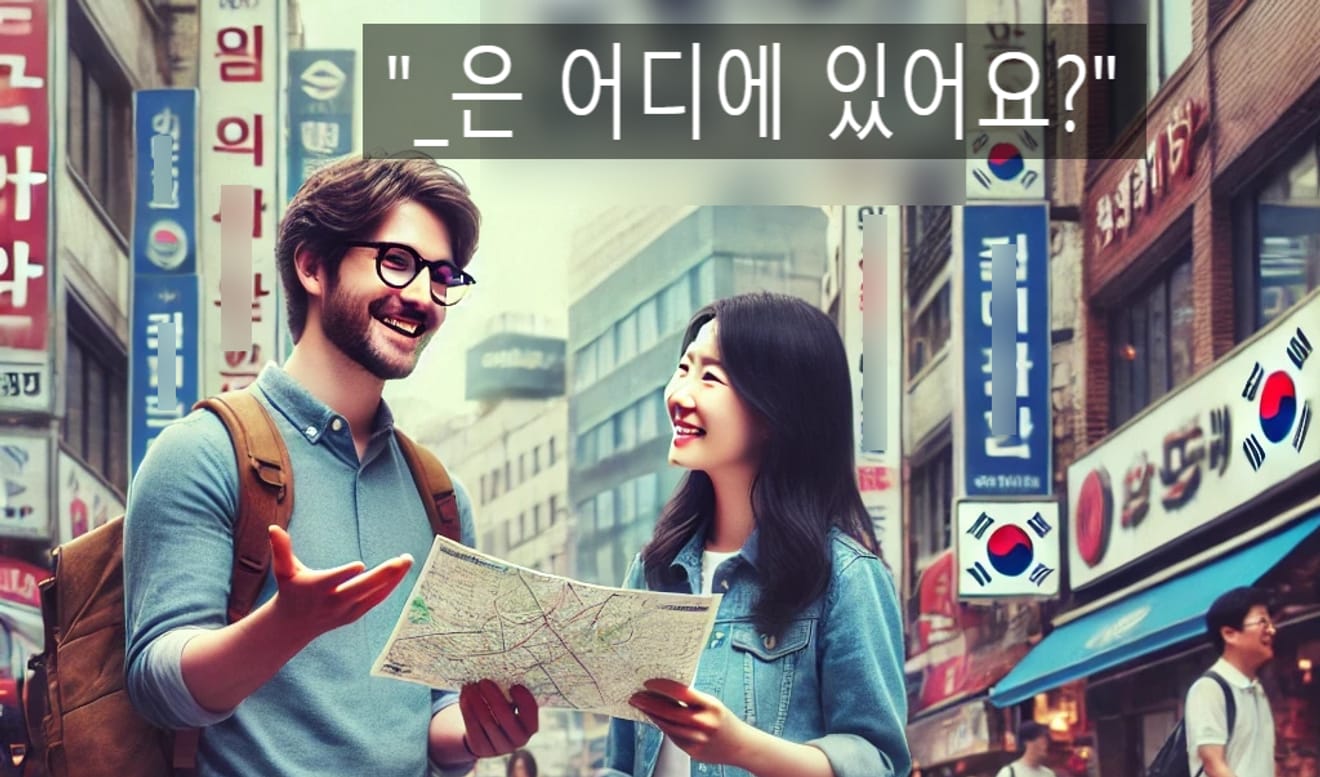- 카카오맵
- 당신을 좋은 곳으로 안내 할 지도
Hello! Today, we will learn one of the essential phrases for traveling in Korea: "Where is ___?". This phrase is very useful when asking about the location of a specific place or object. In this post, we will cover the meaning, pronunciation, various applications of "Where is ___?", and useful tips for finding your way around in Korea.

1. Basic Meaning of "___eun eodie isseoyo?"
1) Expression
___eun eodie isseoyo?
(___eun eo-di-e i-sseo-yo?)
→ Meaning: Where is ___?
2) Pronunciation
___eun (___eun): Depending on the preceding word, "eun" is pronounced as "eun" or "neun".
eodie (eo-di-e): "eo" is similar to the English "uh", and "di-e" connects smoothly.
isseoyo (i-sseo-yo): "i" is pronounced as "ee", and "sseo-yo" sounds like "ssaw-yo".
3) Importance of Honorifics
In Korea, it is important to ask for directions politely. "___eun eodie isseoyo?" is a polite way to ask for a location and can be used with anyone.
2. Situations Where You Can Use "___eun eodie isseoyo?"
1) When asking about a specific place
"Hwajangsil-eun eodie isseoyo?"
(Where is the restroom?)
"Seoul-yeok-eun eodie isseoyo?"
(Where is Seoul Station?)
2) When looking for a specific item
"ATM-eun eodie isseoyo?"
(Where is the ATM?)
"Jihacheol noseondo-neun eodie isseoyo?"
(Where is the subway map?)
3) When asking for directions
"I geonmul-ui jeongmun-eun eodie isseoyo?"
(Where is the main entrance of this building?)
"I beoseu jeongryujang-eun eodie isseoyo?"
(Where is this bus stop?)
3. Various Applied Expressions
1) Asking about location
"Geuncheo-e pyeonieom-i eodie isseoyo?"
(Where is the nearest convenience store?)
"I geuncheo-eseo jeil gakkaun kafe-neun eodie isseoyo?"
(Where is the nearest café around here?)
2) Asking based on landmarks
"N Seoul Tower-neun eodie isseoyo?"
(Where is N Seoul Tower?)
"Myeongdong geori ipgu-neun eodie isseoyo?"
(Where is the entrance to Myeongdong Street?)
3) Asking about the location of an object
"Usan-eun eodie isseoyo?"
(Where is the umbrella?)
"Gabang-eun eodie isseoyo?"
(Where is the bag?)
4. Frequently Heard Responses
1) Giving directions
"Jeojjok-euro jjuk gaseyo."
(Go straight that way.)
"Oreunjjok-euro gasimyeon baro boyeoyo."
(Turn right, and you’ll see it right away.)
2) Explaining nearby locations
"I geonmul 2cheung-e isseoyo."
(It’s on the second floor of this building.)
"Geonneoppyeon-e isseoyo."
(It’s across the street.)
3) Explaining distance
"Georeoseo 5bun georiyeyo."
(It’s a 5-minute walk.)
"Taeksi-ro 10bun geollimnida."
(It takes 10 minutes by taxi.)
5. Useful Tips for Finding Your Way
1) Using map apps
In Korea, **Naver Map (Naver Map)** and **KakaoMap (Kakao Map)** are very useful.
Naver Map direct link - https://map.naver.com/
KakaoMap direct link - https://map.kakao.com/
2) Using landmarks and buildings
Referring to a map or asking for directions based on nearby landmarks can make it easier to find your way.
Example: "Jeogi boineun keun building dwie isseoyo." (It’s behind that tall building over there.)
3) Learning basic Korean phrases
Learn useful questions besides "___eun eodie isseoyo?"
"Yeogieoseo gakkaun pyeonieom-i mwoyeyo?"
(What is the closest convenience store from here?)
"Gajang gakkaun jihacheol-yeok-eun eodie isseoyo?"
(Where is the nearest subway station?)
6. Practical Conversation Examples
Example 1: General question
Tourist: "Hwajangsil-eun eodie isseoyo?"
(Where is the restroom?)
Local: "Jeogi oreunjjok-euro gasimyeon na-omnida."
(Go to the right over there, and you’ll find it.)
Example 2: At a tourist spot
Tourist: "Gyeongbokgung-eun eodie isseoyo?"
(Where is Gyeongbokgung Palace?)
Local: "I gil-eul ttaragamyeon oenjjok-e isseoyo."
(Follow this road, and it’ll be on your left.)
Example 3: At a shopping mall
Customer: "ATM-eun eodie isseoyo?"
(Where is the ATM?)
Staff: "3cheung ellibeiteo yeop-e isseoyo."
(It’s next to the elevator on the third floor.)
7. Frequently Asked Questions (FAQ)
Q: What is the difference between "eodie isseoyo?" and "eodie innayo?"
A: Both expressions have the same meaning, but **"eodie innayo?"** sounds more polite.
Q: Can I ask for directions in English?
A: English is spoken in major tourist areas, but using simple Korean phrases will result in a more friendly response.
Q: What is the first thing to do when you get lost?
A: Check your map or ask for help from those around you. Asking staff at nearby stores or public places is also a good idea.
8. Today’s Summary
"___eun eodie isseoyo?"is an essential phrase to know when traveling in Korea, and it is very useful when asking about the location of a specific place or object. Use the expressions and application methods learned today to make finding your way easier and more enjoyable!
What places did you ask about the most during your trip to Korea? Or if you have any other Korean phrases you want to learn, please share them in the comments!


Comments0